Salmon River Restoration Council
- Overview
- Fire History
- Fuels Reduction
- SR Fire Safe Council
- Program Contact
Overview
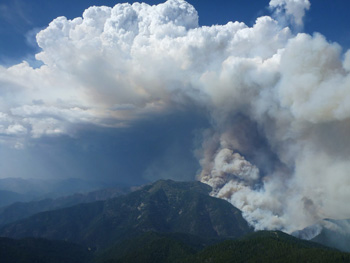
2014 Whites Fire pyrocumulus cloud from Eddy Gulch Lookout
Photo by Ruben Contreras
Uncharacteristically intense wildfire is the single greatest threat to fisheries, ecosystem health, and biodiversity in the Salmon River watershed.
The SRRC began the Fire, Fuels, and Forestry Program in 1994 to help reduce the likelihood of landscape-scale wildfires and reduce the risks that they pose for the watershed.
The program includes the operation of the Salmon River Fire Safe Council, prioritized fuel reduction activities performed by local crews, the development and implementation of a Community Wildfire Protection Plan and detailed neighborhood fire safe plans, and the Community Liaison Program that provides essential community support services in the event of a wildfire. SRRC is an active participant in the Western Klamath Restoration Partnership (WKRP) and a primary organizer and participant in the Salmon River subgroup devoted to developing a collaborative land management paradigm aimed at restoring natural fire resiliency in the Salmon River watershed.
The SRRC also hosts events such as Fire Awareness Week, fire safety training, and volunteer fuels reduction workdays.
Fire History
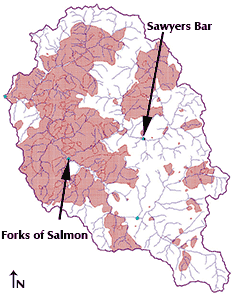
Fire Perimeters (1911-2007)
A Fire-Adapted Landscape
In its natural state, the Salmon River watershed is a fire-adapted landscape that has evolved with a relatively frequent recurrence of non-catastrophic wildfires. Naturally-occurring wildfires are ignited by lightning strikes during infrequent but powerful summer thunderstorms.
With the natural balance of fire and the resulting fuel consumption, wildfires typically did not devastate large areas of the watershed but instead burned more slowly, lower to the ground, and did not damage large areas of soil or consume vast stands of forest. Many components of the ecosystem require fire to maintain their natural balance and species composition.
Fire: Out of Balance
The balance of natural, fuel-reducing fire occurrence was changed with the advent of large-scale fire suppression in the early 1900s. Early fire suppression efforts were generally successful and kept many areas from experiencing wildfire. As an unintended result of preventing nearly all natural fires, fuel loads increased throughout the watershed. Ultimately, any fire not suppressed would grow many times its natural potential size as it consumed this additional fuel load. In essence, fire suppression demanded further suppression in order to prevent conflagrations. Logging, road-building and other activities also significantly increased fuel loads.
| Year | Fire Name | Acres |
|---|---|---|
| 1973 | Offield | 8,200 |
| 1977 | Hog | 50,000 |
| 1987 | 1987 Complex | 90,900 |
| 1994 | Specimen | 7,500 |
| 2002 | Forks | 1,387 |
| 2006 | Bake Oven* | 1,774 |
| 2006 | Uncles Complex | 48,085 |
| 2008 | Ukonom Complex | 80,000 |
| 2009 | Backbone & Red Spot* | 6,324 |
| 2013 | Forks Complex (arson) | 38,000 |
| 2014 | July Complex | 34,000 |
| 2014 | Happy Camp Complex* | 11,000 |
| 2017 | Orleans Complex* | 9,978 |
| 2017 | Salmon August Complex (Wallow Fire)* | 56,854 |
| * = portion of fire in Salmon River watershed | ||
Complete suppression is, of course, not possible and the Salmon River watershed began experiencing series of large, catastrophic wildfires beginning in the second half of the 20th century. It is estimated that over 69% of the watershed has burned since 1911, with more than half of that having burned since 1977. Between 2000 and 2017, over 50% of the watershed has burned in wildfires. Some areas have burned more than once. For example, many areas burned in the 1977 Hog Fire burned again in the 1987 Complex (and some of these again in 2002 and 2008). The Hog Range, near Forks of Salmon, has one of the greatest number of fire overlaps in the region with some areas having burned five times since 1910. Still, there is a significant fire defecit even on the Hog Range where the natural fire recurrence interval is approximately 5-10 years.
2008 was another large wildfire year. The Ukonom Complex, Bear Wallow Complex and Gould Complex burned in the Salmon River.
On July 31, 2013, at least seven arson fires were lit along the Salmon River Road and Sawyers Bar Road. Ultimately, these fires merged to form two large fires, one on the North Fork Salmon and the other on the mainstem Salmon River. In all, 38,000 acres burned.
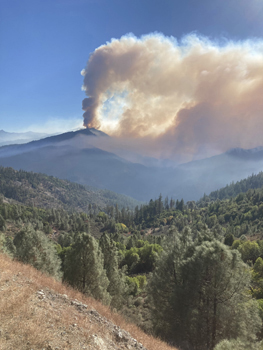
View of the Red Salmon Fire, 2020
Photo by Karuna Greenberg
A dry lightning storm on July 29, 2014 ignited 26 fires in Siskiyou County including the Whites Fire (July Complex) in the Salmon River watershed just south of the Russian Wilderness area in the North Fork drainage. Despite the record dry conditions, this fire burned relatively slowly for the first ten days before unexpectedly jumping the North Fork on August 10 and then exploding on the 11th and 12th in the vicinity of Sawyers Bar. A large pyrocumulonimbus cloud from a blowup in Robinson Gulch (Tanners Peak) on August 11th sent lightning across the landscape to the northwest, starting aproximately 30 new wildfires including the Man Fire at the headwaters of Wooley Creek and twenty fires in the Happy Camp area (Happy Camp Complex). Several unoccupied structures were lost in the Russian Creek area. As of August 16, 2014 the fire was still burning vigorously and preliminary map analysis showed that 16% of the Salmon River watershed had burned in the prior 12.5 months. Later that summer, the Happy Camp Complex fire burned additional acreage in the Salmon River watershed and ultimately mergred with the Man Fire in the southern vicinity of Marble Mountain. By all accounts, 2014 was an epic fire season.
Need for Action
The Salmon River watershed is one of the highest risk fire areas on the entire Klamath National Forest and has had the greatest concentration of wildfires in Siskiyou County. Recent fire histories point to the need for a programmatic approach to reducing fuel loads throughout the watershed and restoring the natural role of fire.
Fuels Reduction
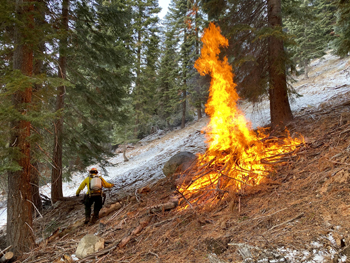 Prescribed burn fuels reduction at
Taylor Hole 2020
Photo by Karuna Greenbergg
Prescribed burn fuels reduction at
Taylor Hole 2020
Photo by Karuna GreenberggThe Salmon River Restoration Council began implementing a fuels reduction program in 1995.
Though the creation of shaded fuel breaks, we have treated over 1000 acres on 70 parcels of private land. Funding has been provided by the US Fish & Wildlife Service, the Bureau of Land Management, and the US Forest Service.
Each project features the selected release of native plants which are the most fire resistant and which provide shade for the fuel breaks and riparian areas. In several of our projects, previously fire-denuded areas were planted with selected native plants grown in our local cooperative nursery facilities.
Nearly all private property on the Salmon River that experienced wildfire in 2013 and 2014 had been treated by SRRC's fuels reduction crews in recent months or years prior to the fires. This was a real opportunity to test the effectiveness of SRRC's fuels reduction work and by every measure, it was an astounding success and contributed enormously to minimizing fire behavior, protecting homes and property values, and providing a safe environment for firefighters.
In late 2014, SRRC began using prescribed fire as a tool for fuels reduction and habitat improvement on private property. Since then, SRRC has conducted over 85 acres of broadcast burning on five properties throughout the watershed. Each of these prescribed burns have been located adjacent to homes in the Wildland Urban Interface, and we have now burned adjacent to nearly 20 homes. These controlled burns help protect homes and other improvements from wildfire by burning off ground fuels when conditions allow fire to burn at a low intensity. Prescribed fire also has numerous ecological benefits and aids in restoring the landscape to a more natural fire regime, helping to reduce the impacts of wildfire in the future. Our use of prescribed fire is closely coordinated with our manual fuels reduction work.
Salmon River Fire Safe Council
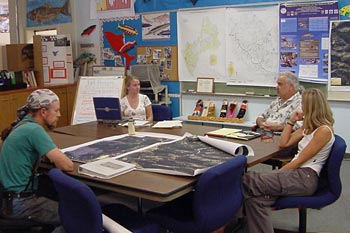 Fire Safe Council Meeting
at SRRC Watershed Center
Fire Safe Council Meeting
at SRRC Watershed Center The Salmon River Fire Safe Council (SRFSC) formed in 2000 in order to get more involvement from agencies and the community on fire issues.
Mission
The mission of the SRFSC is to help plan, implement and monitor the reinstatement of natural fire regimes in the Salmon River ecosystem in a manner that protects life and property, improves forest health, and enhances the resources valued by its stakeholders.
Community Wildfire Protection Planning
The Fire Safe Council has been working on two levels of fire planning. In 2007, we completed a Community Wildfire Protection Plan (CWPP) for the entire watershed and now, in 2019, we are in the early stages of developing a completely new CWPP that will utilize the latest methods of fire planning. We are also developing more detailed CWPPs for the towns and neighborhoods in the watershed.
Working in Partnership
The SRRC and the Forest Service work together to develop partnership agreements and memorandums of understanding for various resource protection, enhancement, and awareness projects in the Salmon River watershed.
Through the Fire Safe Council, we are coordinating fire planning and fuel reduction activities with community members, the Karuk Tribe, CAL FIRE, US Fish & Wildlife Service, National Marine Fisheries Service, Salmon River Volunteer Fire and Rescue, the Salmon River and Orleans Ranger Districts, and others.
Community Fire Liaison Team
Salmon River community members coordinating with local representatives of the Salmon River Fire Safe Council, Salmon River Volunteer Fire & Rescue and the SRRC are working with CAL FIRE and the Klamath National Forest fire personnel as a liaison team of community fire specialists. The purpose of the team is to provide information to Incident Management Team's fire planners and to provide the local communities with accurate up-to-date local fire news. The local liaison team members consist of residents from the Sawyers Bar, Cecilville, Forks of Salmon and Somes Bar area.
The Salmon River FSC had its first opportunity to implement the new Fire Liason Program during the 2009 fires and has implemented it to great success in the simultaneous 2013 wildfires and the 2014 wildfires. Salmon River's liaisons have received awards from the US Forest Service for their exceptional work. Our liaison program is now being used as a model program for other areas in the country.
For folks who are interested in becoming involved in this process, Salmon River Fire Safe Council meetings are held quarterly. See the calendar for meeting times and locations.
Meetings
The Salmon River Fire Safe Council holds quarterly meetings to deal with many issues including thedevelopment of community and neighborhood fire safe plans; water source (tanker fill sites) identification, mapping and signing; road signing; private properties universal number signage, helispot location and mapping; community outreach and education; training; water tanks and hydrant systems; general cooperation and sharing with stakeholders and agencies.
Please see our calendar for upcoming meeting dates. Salmon River Fire Safe Council meetings are held quarterly, usually on the last Wednesday of the month.
Program Contact
Alex Varner
Fire, Fuels, & Forestry Program Manager
Salmon River Restoration Council
PO Box 1089
25631 Sawyers Bar Road (shipping only)
Sawyers Bar, CA 96027
phone: 530-462-4665
fax: 530-462-4664


Salmon River Restoration Council
PO Box 1089 | Sawyers Bar, CA | 96027
Salmon River (California)
530-462-4665
![]()